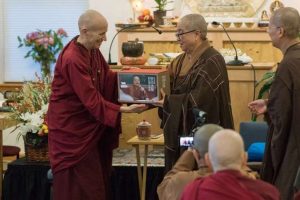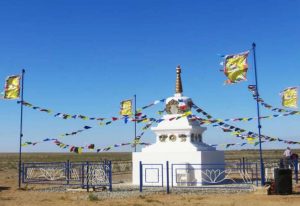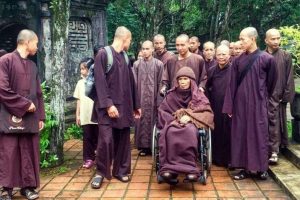
There are no known direct historical or cultural connections between Western culture’s faerie religion of the Celtic isles, with its faeries, nymphs, and sprites, and the dakinis, apsaras, feitians, and khandum of Asian religions. Thematic similarities between them all fascinate a current generation of contemporary women practitioners, dancers, and scholars, who are interested in female empowerment traditions, whether Tantric chöd practice, Shinto priestess (miko) spirit-mediumship, Newar Charya goddess dances, Vajrayana nuns performing dakini cham, or druid priestesses, naked, in a trance, “Running the Hunt.” Wicca and tantra, authentic movement and embodied spiritual practices are growing in popularity among women seekers of wisdom, who are often interested in all of these traditions. Four of these women and their work will be individually introduced in Part Two of this series.

Tinker Bell doesn’t help explain faerie culture very much, but even she behaves randomly and is a little bit threatening. Faerie religion is not all about female beings, nor only about benign beings (witches in fairytales want to eat children.) Oberon is the faerie king and Tatiana his queen in Shakespeare’s A Midsummer Night’s Dream. English poet Edmund Spencer wrote The Faerie Queene, which was set to music by early baroque composer Henry Purcell.For the purposes of this article, I will focus on the female faeries to show similarities with their Asian female esoteric counterparts. These similarities are likely the products of the universality of human experience, nature-based religions, and esoteric symbolism, corresponding to mystical practice.
Faeries and apsaras, dakinis and feitians alike are nature spirits, understood as supernatural (non-human) beings. They are often depicted in fantastical landscapes of mountains, rivers, fountains, oceans, forests, waterfalls, rainbows, and the sky—at the same time symbolizing mystical realities, much like the nagas do in Buddhist art, swimming in the waters of Padmasambhava’s mystical paradise, Zangdokpalri. There are celestial and terrestrial Celtic nymphs and faeries, just as there are celestial and terrestrial tantric dakinis, Hindu apsaras, Chinese feitians, and Shinto kami. Limber and acrobatic, often they fly, sometimes they swim, usually they dance.

Shinto shrine priestess (miko) dancing Kagura. Scroll painting, Japan, c. 1900. Image courtesy of Core of Culture
Whether used to stabilize meditation or to engage some power of nature, faeries, dakinis, and apsaras are beautiful and alluring, leading and guiding, charming and seductive: attention-holding. Enchantment is part of their connection to humans. All of these female energies dance, engage with otherworldly music, chant magical syllables, and represent a higher state of consciousness. These female powers are considered transmitters of wisdom.
While there is no evidence to suggest that these various religions influenced each other. It is compelling that they each feature female empowerment practices and symbolic expressions that bear comparison. Beyond the experiential connections that women today are making with all these traditions, as well as with Wicca, Kabbalah, and druidism, there is also an almost-forgotten figure who linked them in his scholarly work, with dramatic and widely influential results.

The cross-cultural pioneer who heralded tantric Buddhist practices in the West, Walter Yeeling Evans-Wentz (1878–1965), introduced millions of Westerners to Buddhism through his edition of The Tibetan Book of the Dead (1927). It remains the best-selling version of the text for its seminal power, and the beauty of its language. Evans-Wentz also introduced the West to Tibet’s mystic poet Milarepa (1928), to The Six Yogas of Naropa (1935), and to The Tibetan Book of the Great Liberation (1954). He was nearly 50 years old when he began his work in the Himalayas concerning the production of The Tibetan Book of the Dead.
Not as well as known as The Tibetan Book of the Dead (a title that he originated), Evans-Wentz doctoral dissertation was written in French for the Université de Rennes, Brittany. Upon completing his doctorate, he did post-doctoral work at Oxford University, expanding on the subject of the faerie religion of the Celtic isles that was introduced in his dissertation, now expanded to include Scotland, and under the supervision of Oxford dons. He was awarded a bachelor of science for that work, The Fairy Faith in Celtic Countries. It can be read in its entirety online, although it is not for the fainthearted, being extremely well-researched and quite complex. He writes:
By the Celtic Fairy-Faith we mean that specialized form of belief in a spiritual realm inhabited by spiritual beings which has existed from prehistoric times until now in Ireland, Scotland, Isle of Man, Wales, Cornwall, Brittany, or other parts of the ancient empire of the Celts.

Evans-Wentz published his work on the faerie religion in 1911, after completing his doctorate—almost 15 years before he began work on producing Buddhist editions for Western readers. It is important to provide some context here. The first academic department of Buddhism in the West was established in Germany in 1904. There was no robust academic Buddhist culture to support his fieldwork. Evan-Wentz was not a translator, nor a linguist. He was an anthropologist. Some would contend that anthropology began with the Greek historian Herodotus, but most would say anthropology began with Franz Boas and his peers who established anthropology as a valid social science in the late 19th century.
In the early 20th century, anthropology, along with other disciplines, was greatly influenced by Darwin’s theory of evolution, and comparative studies—drawing connections between disparate cultures—were common, such as in comparative religion. Ethnographic documentation, including first-hand fieldwork, became a standard professional way of conducting research. Evans-Wentz was a superb ethnographer, collecting stories, myths, and cultural practices among the local populations in Himalayan India, and also, within Celtic lands. Anthropology was an evolving field, focusing on indigenous cultures of foreign lands. Archeology was emerging from it as a distinct discipline. Buddhist studies were nascent.
Evans-Wentz was a true pioneer, and for all the flaws that critics ascribe to him and other personalities of his time, his cultural impact cannot be denied, and it is still being felt. I would guess this is because of the integrity of the man, which is admirable. Evans-Wentz is not without his well-placed detractors. As with other Theosophists—and like other pioneering explorers in the fields of spiritual knowledge—he was considered controversial, eccentric, and fueled by a romantic imagination that is claimed to have tainted his understanding. His output is testimony enough of his excellence, flaws and all. He lived a free, noble, and high-minded life, on his own terms. His fanbase continues to grow, even among contemporary women practitioners of female empowerment practices, encountering his work for the first time.

In those days, cultural diversity was not something most Westerners experienced. In the early 20th century, race-based theories were popular, alongside the concept that humankind evolved from a savage state to civilized one. Anthropology as a discipline came to forgo the primacy of the Western viewpoint in favor of a cultural relativism, aspiring to understand cultures on their own terms. Evans-Wentz learned of Theosophy—a religious movement founded by Madame Blavatsky, Harry Olcott, and William Judge in 1875—first from his father and later again at Oxford University. It was a potpourri of Neo-Platonist transcendentalism with some Hindu and Buddhist teachings seasoning the mix.
Theosophy continues to exist; its headquarters now are in Wheaton, Illinois. For all its romantic idealization of universal, ancient, wise teachers, it aspired to seek wisdom from other cultures, and to learn from that wisdom. This noble stance was ahead of its time. Theosophy was influential for introducing the West to Asian religions and to ancient wisdom teachings. Many important people were connected to Theosophy at one point or another: T. S. Eliot, Arthur Conan-Doyle, Thomas Edison, and William Butler Yeats, for example. It arose when the world did not know itself, when race-based theories of understanding were current, and actual contact between cultures was scant.

While other scholars were seeking to understand how the savages of foreign cultures became civilized, Theosophists were looking for wisdom. Evans-Wentz was motivated to share the wisdom he encountered with the world. He was not after academic distinction, nor commercial success. As wacky as Theosophists, who were an international organization, may appear today, their concepts of spiritual evolution and the necessity of ancient teachings in the world made a huge and positive influence on Western society’s impression of Asia, and wisdom teachings in general. Evans-Wentz identified as a Theosophist throughout his life. His major works were published by Oxford University and were critically acclaimed on release. (One of my prized possessions is a first edition, four-volume set of Evans-Wentz’ Tibetan works.)
I’ve not been able to find the field notes of Evans-Wentz in Ladakh. If his Fairy Culture in Celtic Countries—which includes fieldwork in Ireland, Scotland, the Isle of Man, Wales, Cornwall, and Brittany—is any indication, then we can assume his work was thorough, humble, transparent, and as precise as language allows. Evans-Wentz had many close advisors, but no finer guide through the Irish mystical religion than the poet Yeats, who personally accompanied Evans-Wentz, after befriending him in California, guiding him and sharing his passion. It requires a cultural reset to appreciate what Evans-Wentz accomplished with his research unto faery religion.

In the first years of the 20th century, field research was on foot. Cars were uncommon, certainly in Celtic villages in remote coastal areas of the North Atlantic. The technology of the day did not provide for the simple use of cameras, which were increasingly being used in exploration but were not research staples in the first decade of the 20th century. This meant that Evans-Wentz’s extraordinary account of Celtic mystical folklore was done on foot and by hand. His writing was compelled to convey the knowledge necessary to sustain his compendious research. I’ve commented before how many early explorers were exceptional writers—because they had to be. Evans-Wentz is a masterful writer, descriptive and logical, and his work is an example of a man from a just-modern society surveying a pre-industrial belief system. For these reasons, his work The Fairy Faith in Celtic Countries is required reading for any serious student of Celtic religion, folklore, and culture.
The footnotes in the four volumes of Evans-Wentz’s editions of Tibetan spiritual teachings reveal his own surmising as he presents texts of the teachings. I remember thinking 30 years ago how odd that he saw comparisons between Padmasambhava and St. Patrick. Now, understanding his deep knowledge of Celtic belief and the complex nature of the symbol of St. Patrick as introducer of a new religion in a land already bursting with nature deities, I am keen to know more precisely what he meant, and want to reread it. It’s a fascinating observation from a broadminded, forward-thinking, well-researched, wisdom-seeker. Much of faerie belief involved death, and, remarkably, Celtic religion has an understanding of rebirth comparable to reincarnation in Tibetan Buddhism.

I’ll end as I began, asserting there is no causal or cultural connection between faeries and dakinis and kami and apsaras. It is worth noting, nevertheless, that the person who produced an enduring standard work on Celtic faerie religion is also the introducer of Tibetan spiritual practices to the West, that are, in part, based on the actions of female deities: animal-headed ferocious dakinis, khandum, in the Tibetan Book of the Dead; yogini-based visualization techniques as a fundamental building block of meditation practice in The Six Yogas of Naropa. Evans-Wentz had the graceful ability not only to appreciate the evolutionary zeitgeist of his time, but to participate in it, with the cultural watershed that was The Tibetan Book of the Dead. All this on a foundation of faeries and folklore.
Next month, Part Two introduces four women practitioners exploring ancient female empowerment traditions today.
See more
Core of Culture
Project Gutenberg’s The Fairy-Faith in Celtic Countries, by W. Y. Evans Wentz (Project Gutenberg)
Related features from BDG
Faeries, Dakinis, Nuns, and Mikos, Part Two
Faeries, Dakinis, Nuns, and Mikos, Part Three














Fascinting to learn so much about Evans-Wentz! Thanks for this eye-opeing article